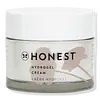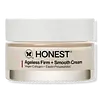What's inside
What's inside
 Key Ingredients
Key Ingredients

 Benefits
Benefits

 Concerns
Concerns

No concerns
 Ingredients Side-by-side
Ingredients Side-by-side

Water
Skin ConditioningSqualane
EmollientGlycerin
HumectantPolyglyceryl-4 Isostearate
EmulsifyingPyrus Malus Fruit Extract
Skin ConditioningCoco-Caprylate/Caprate
EmollientPropanediol
SolventDisteardimonium Hectorite
StabilisingJojoba Esters
EmollientSodium PCA
HumectantTocopherol
AntioxidantSodium Acetylated Hyaluronate
HumectantHydrolyzed Sodium Hyaluronate
Skin ConditioningTrisodium Ethylenediamine Disuccinate
Ceramide AP
Skin Conditioning1,2-Hexanediol
Skin ConditioningCaprylhydroxamic Acid
Water, Squalane, Glycerin, Polyglyceryl-4 Isostearate, Pyrus Malus Fruit Extract, Coco-Caprylate/Caprate, Propanediol, Disteardimonium Hectorite, Jojoba Esters, Sodium PCA, Tocopherol, Sodium Acetylated Hyaluronate, Hydrolyzed Sodium Hyaluronate, Trisodium Ethylenediamine Disuccinate, Ceramide AP, 1,2-Hexanediol, Caprylhydroxamic Acid
Water
Skin ConditioningHelianthus Annuus Seed Oil
EmollientBrassica Alcohol
EmollientGlycerin
HumectantIsostearyl Hydroxystearate
EmollientCaprylic/Capric Triglyceride
MaskingButyrospermum Parkii Butter
Skin ConditioningCetyl Alcohol
EmollientCetearyl Olivate
Sorbitan Olivate
EmulsifyingPropanediol
SolventDimethicone
EmollientMagnesium Aluminum Silicate
AbsorbentSh-Polypeptide-121
Skin ConditioningSh-Polypeptide-50
Skin ConditioningHydrolyzed Sodium Hyaluronate
Skin ConditioningSodium Acetylated Hyaluronate
HumectantSaccharomyces/Sugarcane Juice Extract Ferment Extract
Skin ConditioningThymus Vulgaris Flower/Leaf Extract
MaskingXanthan Gum
EmulsifyingLecithin
EmollientTocopherol
AntioxidantXylitol
HumectantCetyl Palmitate
EmollientSorbitan Palmitate
EmulsifyingCaprylic Acid
CleansingMyristyl Alcohol
EmollientStearyl Alcohol
EmollientLauryl Alcohol
Emollient1,2-Hexanediol
Skin ConditioningCaprylhydroxamic Acid
Isostearyl Alcohol
EmollientHydroxystearic Acid
CleansingCitric Acid
BufferingTrisodium Ethylenediamine Disuccinate
Potassium Sorbate
PreservativeSodium Benzoate
MaskingWater, Helianthus Annuus Seed Oil, Brassica Alcohol, Glycerin, Isostearyl Hydroxystearate, Caprylic/Capric Triglyceride, Butyrospermum Parkii Butter, Cetyl Alcohol, Cetearyl Olivate, Sorbitan Olivate, Propanediol, Dimethicone, Magnesium Aluminum Silicate, Sh-Polypeptide-121, Sh-Polypeptide-50, Hydrolyzed Sodium Hyaluronate, Sodium Acetylated Hyaluronate, Saccharomyces/Sugarcane Juice Extract Ferment Extract, Thymus Vulgaris Flower/Leaf Extract, Xanthan Gum, Lecithin, Tocopherol, Xylitol, Cetyl Palmitate, Sorbitan Palmitate, Caprylic Acid, Myristyl Alcohol, Stearyl Alcohol, Lauryl Alcohol, 1,2-Hexanediol, Caprylhydroxamic Acid, Isostearyl Alcohol, Hydroxystearic Acid, Citric Acid, Trisodium Ethylenediamine Disuccinate, Potassium Sorbate, Sodium Benzoate
 Reviews
Reviews

Ingredients Explained
These ingredients are found in both products.
Ingredients higher up in an ingredient list are typically present in a larger amount.
1,2-Hexanediol is a synthetic liquid and another multi-functional powerhouse.
It is a:
- Humectant, drawing moisture into the skin
- Emollient, helping to soften skin
- Solvent, dispersing and stabilizing formulas
- Preservative booster, enhancing the antimicrobial activity of other preservatives
Caprylhydroxamic Acid is a chelating agent.
Chelating agents help prevent metal ions from binding to other ingredients. This helps prevent unwanted reactions and effects from using the product.
Caprylhydroxamic Acid is often used with natural antimicrobial products as an alternative to preservatives.
Learn more about Caprylhydroxamic AcidGlycerin is already naturally found in your skin. It helps moisturize and protect your skin.
A study from 2016 found glycerin to be more effective as a humectant than AHAs and hyaluronic acid.
As a humectant, it helps the skin stay hydrated by pulling moisture to your skin. The low molecular weight of glycerin allows it to pull moisture into the deeper layers of your skin.
Hydrated skin improves your skin barrier; Your skin barrier helps protect against irritants and bacteria.
Glycerin has also been found to have antimicrobial and antiviral properties. Due to these properties, glycerin is often used in wound and burn treatments.
In cosmetics, glycerin is usually derived from plants such as soybean or palm. However, it can also be sourced from animals, such as tallow or animal fat.
This ingredient is organic, colorless, odorless, and non-toxic.
Glycerin is the name for this ingredient in American English. British English uses Glycerol/Glycerine.
Learn more about GlycerinThis ingredient is created by putting sodium hyaluronate through hydrolysis.
You might know this as 'mini' or 'ultra low-molecular weight' hyaluronic acid. The small molecule size means it is able to travel deeper in the skin.
According to studies, low molecular-weight hyaluronic acid can:
One study from 2011 found ultra-low weight HA to show pro-inflammatory properties. Another study from 2022 found it to downregulate UV-B induced inflammation.
Hydrolysis is a process of changing a molecule using water or enzymes.
This ingredient is water-soluble.
Learn more about Hydrolyzed Sodium HyaluronatePropanediol is an all-star ingredient. It softens, hydrates, and smooths the skin.
It’s often used to:
Propanediol is not likely to cause sensitivity and considered safe to use. It is derived from corn or petroleum with a clear color and no scent.
Learn more about PropanediolSodium Acetylated Hyaluronate is a type of Hyaluronic Acid.
Hyaluronic Acids help moisturize, soothe, and protect the skin.
Read about common types of Hyaluronic Acid here:
Sodium Hyaluronate
Hydrolyzed Hyaluronic Acid
Hyaluronic Acid
Tocopherol (also known as Vitamin E) is a common antioxidant used to help protect the skin from free-radicals and strengthen the skin barrier. It's also fat soluble - this means our skin is great at absorbing it.
Vitamin E also helps keep your natural skin lipids healthy. Your lipid skin barrier naturally consists of lipids, ceramides, and fatty acids. Vitamin E offers extra protection for your skin’s lipid barrier, keeping your skin healthy and nourished.
Another benefit is a bit of UV protection. Vitamin E helps reduce the damage caused by UVB rays. (It should not replace your sunscreen). Combining it with Vitamin C can decrease sunburned cells and hyperpigmentation after UV exposure.
You might have noticed Vitamin E + C often paired together. This is because it is great at stabilizing Vitamin C. Using the two together helps increase the effectiveness of both ingredients.
There are often claims that Vitamin E can reduce/prevent scarring, but these claims haven't been confirmed by scientific research.
Learn more about TocopherolTrisodium Ethylenediamine Disuccinate is used to help stabilize a product.
It is a chelating agent, meaning it helps prevent metal ions from binding to other ingredients. This prevents unwanted reactions in products. Metal ions can come into a product via the water ingredient. They are found in trace amounts and are not known to be harmful.
Water. It's the most common cosmetic ingredient of all. You'll usually see it at the top of ingredient lists, meaning that it makes up the largest part of the product.
So why is it so popular? Water most often acts as a solvent - this means that it helps dissolve other ingredients into the formulation.
You'll also recognize water as that liquid we all need to stay alive. If you see this, drink a glass of water. Stay hydrated!
Learn more about Water